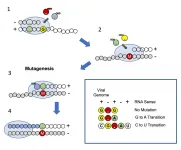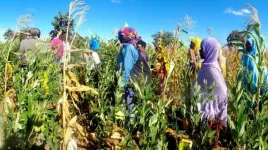(Press-News.org) SALT LAKE CITY - Today in Nature Communications, researchers at Huntsman Cancer Institute at the University of Utah report critical new insights into how cells mount an attack against melanoma tumors.
Melanoma is an aggressive type of skin cancer that can arise from excess exposure to sun, frequent sunburns, genetics, and other environmental factors. Melanoma, like all cancers, begins within cells. Specially designed and refined over billions of years, cells are experts at working to root out and fix routine errors that arise. A tumor begins when a cell makes faulty copies of itself over and over again. If left unchecked, these faulty cell copies continue to grow into complex ecosystems that become tumors. Some tumors, like melanomas, can go on to develop mechanisms to sustain themselves with blood flow and oxygen. They can also send the cancerous cells through the body to proliferate in other organs, which ultimately causes death.
Immunotherapy, which trains the immune system to fight cancer cells, can sometimes be effective in treating melanomas. Some patients experience a long-lasting and durable response to immunotherapies. Yet many patients' tumors soon learn how to outsmart the drugs.
Understanding how cells mount a defense against an aggressive tumor like melanoma piqued the curiosity of Ryan O'Connell, PhD, a cancer researcher at HCI and professor of pathology at the University of Utah Health. His lab works to understand how immune cells and cancer cells interface. He wants to better understand the sophisticated metabolic processes within and around cells and to use those insights to develop more effective cancer therapies.
In this study, O'Connell and his team uncovered a key metabolic "switch" driven by an enzyme, nicotinamide phosphoribosyltransferase, or NAMPT. They learned how NAMPT plays an important role in how certain immune cells fight melanoma tumors.
"We were interested in better understanding NAMPT because it is increased in specific immune cells within tumors, called macrophages, in response to a substance secreted by other immune cells, called interferon, which is known to be important for effective antitumor responses," says O'Connell. O'Connell and his team used next-generation RNA sequencing to determine which metabolic genes increase within immune cells in response to different tumor processes.
"NAMPT was a top hit," says O'Connell. The research team found that a specific inflammatory signaling pathway triggers NAMPT. They discovered that when this inducible NAMPT pathway is disrupted, the antitumor function of cells was also impaired.
The study was co-led by Warren Voth, PhD, a research assistant professor and member of the O'Connell Lab. Voth helped design and conduct the experiments to study the role of Nampt and also mentored lab trainees who worked on the project. Using studies of cells in a laboratory setting, Voth helped to understand how NAMPT is induced in immune cells and what happens if the immune cells block NAMPT induction. The research team then created an experiment using a mouse model system and found the same NAMPT pathway was required for the mouse cells to initiate antitumor activity. Next, the team studied data from human tumors using The Cancer Genome Atlas, a federal cancer genomics program that molecularly characterized more than 20,000 primary cancer and matched normal samples across 33 cancer types. The critical role of the NAMPT pathway was also a factor in the genomic data they analyzed.
"Based on this work, we want to understand whether novel therapies that enhance the NAMPT pathway in immune cells in patient tumors could result in improved outcomes," says O'Connell. He hopes the next step will be to understand whether therapies that strengthen this pathway in certain immune cells could be the foundation for more effective treatments. He also wants to understand whether high levels of NAMPT in tumors may predict whether a patient will respond well to some immunotherapies that have inconsistent outcomes.
This work adds to the body of evidence that the metabolic state of tumors, immune cells, and the tumor microenvironment as a whole can have profound impacts on the course of disease by controlling the identity and functionality of immune cells that either fight to destroy the tumor or act to promote cancer growth. O'Connell's team also found strong evidence that this study has applications to other cancer types.
INFORMATION:
This work was supported by the National Institutes of Health/National Cancer Institute including P30 CA042014, and Huntsman Cancer Foundation via a pilot grant from the Melanoma Disease Center at HCI. O'Connell and Voth acknowledge the critical work of the entire research team, particularly study authors Thomas Huffaker, Atakan Ekiz, and Cindy Barba.
Huntsman Cancer Institute (HCI) at the University of Utah is the official cancer center of Utah. The cancer campus includes a state-of-the-art cancer specialty hospital as well as two buildings dedicated to cancer research. HCI treats patients with all forms of cancer and is recognized among the best cancer hospitals in the country by U.S. News and World Report. As the only National Cancer Institute (NCI)-Designated Comprehensive Cancer Center in the Mountain West, HCI serves the largest geographic region in the country, drawing patients from Utah, Nevada, Idaho, Wyoming, and Montana. More genes for inherited cancers have been discovered at HCI than at any other cancer center in the world, including genes responsible for hereditary breast, ovarian, colon, head, and neck cancers, along with melanoma. HCI manages the Utah Population Database, the largest genetic database in the world, with information on more than 11 million people linked to genealogies, health records, and vital statistics. HCI was founded by Jon M. and Karen Huntsman.
A new Dartmouth Engineering study shows that integrating renewable energy into the American Electric Power System (AEPS) would enhance the grid's resilience, meaning a highly resilient and decarbonized energy system is possible. The researchers' analysis is based upon the incremental incorporation of architectural changes that would be required to integrate renewable energy into AEPS.
The paper, "A Hetero-functional Graph Resilience Analysis of the Future American Electric Power System," was recently published by IEEE Access.
"We concluded that there are no structural trade-offs between grid sustainability and resilience enhancements, meaning these strategic goals can be pursued ...
A biochemical reaction between an enzyme called luciferase and oxygen causes fireflies to glow and is considered one of the most well-known examples of bioluminescence in nature. Now, an international team of researchers led by Elena Goun at the University of Missouri is working to harness the power of bioluminescence in a low-cost, noninvasive portable medical imaging device that could one day be applied to many uses in biomedical research, translational medicine and clinical diagnoses.
Potential uses include developing better treatments for cancer, diabetes and infectious diseases, along with monitoring various metabolic functions, such as gut health, in both animals ...
A University of Alberta virology lab has uncovered how an oral antiviral drug works to attack the SARS-CoV-2 virus, in findings published May 10 in the Journal of Biological Chemistry.
The researchers demonstrated the underlying mechanism of action by which the antiviral drug molnupiravir changes the viral genome, a process known as excessive mutagenesis or “error catastrophe.”
“The polymerase, or replication engine of the virus, mistakes molnupiravir molecules for the natural building blocks required for viral genome replication and mixes them in,” ...
Ann Arbor, May 11, 2021 - Social isolation among older adults is associated with poor health and premature mortality, but the connection between social isolation and physical functioning is poorly understood. New research generates more robust evidence about the associations between social isolation and physical functioning and how this accelerates over time, reports the American Journal of Preventive Medicine, published by Elsevier. It also highlights the importance of incorporating strategies to reduce social isolation and promote successful aging.
"Physical functioning is understood to influence the health of individuals. And social isolation is prevalent among older adults," ...
Researchers at UC Santa Cruz have developed a novel chip-based antigen test that can provide ultrasensitive detection of SARS-CoV-2 and influenza A, the viruses that cause COVID-19 and flu, respectively.
The test is sensitive enough to detect and identify individual viral antigens one by one in nasal swab samples. This ultrasensitive technique could eventually be developed as a molecular diagnostic tool for point-of-care use. The researchers reported their findings in a paper published May 4 in Proceedings of the National Academy of Sciences.
"This is a chip-based biosensor capable of detecting individual proteins one ...
Rheumatic heart disease (RHD) remains a major cause of cardiovascular disease in Africa, even as acute rheumatic fever and RHD have become rare in high-income countries. In a new study led by investigators at Brigham and Women's Hospital, the team modeled the investment case for control of RHD in the African Union (AU) region. Results showed the potential to reduce RHD death by almost a third by increasing coverage of RHD interventions in regions of the AU to 2030, with a high return on investment in both the long and short term. Their results are published in The Lancet Global Health.
"Investing in early detection of rheumatic fever and rheumatic heart disease and providing cardiac surgery to those who need it ...
Gram-negative bacteria are the bane of health care workers' existence.
They're one of the most dangerous organisms to become infected with--and one of the hardest to treat. But new research from the University of Georgia suggests a component of bacteria's cell walls may hold the key to crushing the antibiotic-resistant microbes.
The reason Gram-negative bacteria are difficult to kill is their double cell membranes, which create an almost impenetrable shield of protection. This shield blocks antibiotics from entering, preventing medications from doing their job of destroying the bacteria. Meanwhile, toxic molecules, known as lipopolysaccharides, on the surface of the bacteria's outer membrane provoke a potentially deadly immune response.
In ...
ITHACA, N.Y. - A project based in Tanzania found significant improvements in the diversity of children's diets and food security for households after farmers learned about sustainable crop-growing methods, gender equity, nutrition and climate change from peer mentors.
The farmers experimented with practices introduced to them by Malawian farmers and Tanzanian and American scientists, decided which ones to incorporate within their own farms, and met monthly to share experiences and problem-solve.
The three-year study builds on longer-term research where these environmentally-friendly farming methods, called agroecology, combined with peer-mentoring and farmers collaborating in the process, had successfully improved adult nutrition in Malawi.
"There were a lot of questions about whether ...
May 11, 2021 - For patients seen at a urology clinic, patient satisfaction scores vary by insurance status - with higher scores for patients on Medicare and commercial insurance, but lower scores for those on Medicaid, reports a study in Urology Practice®, an Official Journal of the American Urological Association (AUA). The journal is published in the Lippincott portfolio by Wolters Kluwer.
"Our study adds to previous evidence showing patient satisfaction scores are affected by the type of insurance - not just by the quality of care provided," comments senior author Werner de Riese, MD, PhD, Chair of the Department of Urology of Texas Tech University Health Sciences Center ...
Columbia Engineering/UCLA team is first to demonstrate that phase precession plays a significant role in the human brain, and links not only sequential positions, as seen in animals, but also abstract progression towards specific goals.
New York, NY--May 11, 2021-- For decades the dominant approach to understanding the brain has been to measure how many times individual neurons activate during particular behaviors. In contrast to this "rate code," a more recent hypothesis proposes that neurons signal information by changing the precise timing when they activate. One such timing code, called phase precession, is commonly observed in rodents as they navigate through spaces and is thought to form the ...





